If you want to examine the material in a particular Market, select the "Market" segment, using the "Market" button above. Select the Markets button to return to original page. Other links will take you to other destinations.
Thin Skin Concrete
Thin skin concrete is becoming more prevalent than in previous years. The progress of these types of concrete developments has been made possible by the availability of alternate reinforcing products. Concrete is a semi-brittle material and whilst it has excellent qualities when subjected to compressive forces, it is woefully inadequate, without reinforcement to provide it with tensile abilities. When judging the cover required in concrete, thin-skinned products seem to be an anomaly. Constructors KNOW that cover to reinforcing steel is essential for structure durability!
In the cement arena, environmentalists continuously shout for lowered cement production, in order to reduce carbon dioxide emissions. (Cement factories are reputed to produce about 6% of all carbon dioxide release). In order to minimise cement usage, alteration in mix designs has led to less Portland cement in concrete mixes.
Of course, cement chemists have made great strides, by substituting other materials for Portland cement. However, lower binder contents ultimately put structures at risk. We know that lower cement contents have affected durability, in that lower cement contents lead to reduced steel reinforcement protection. Less cement will damage the structures at some point.
What then? In some way, methods to provide structural reinforcement, are required. One method is to get rid of the steel reinforcement that always corrodes, and replace it with other reinforcing materials. Products like glass-fibre, basalt fibre and carbon fibre are all being used. Of course, most glass fibre is susceptible to alkali attack. Basalt does not have the same limitations and carbon fibre if far too costly!
Ultra-thin-skin roads
Thin skinned reinforced concrete roads have been in existence for a few years now. The original development in South Africa, was done by the CSIR. One road was built at a quarry on the West Rand, in Gauteng, and has been taking heavily loaded trucks on a daily basis for many years. Of course, like any trafficable area, the main support of the road surface, is critical. Have a bad substrate and, no matter how good your surface is, there will be failures. For ultra-thin concrete roads (UTRC) roads, the whole construction process must be carefully managed.
Hans Brink and Associates was one of the first companies in South Africa to see the benefits of basalt fibre. A special fibre was developed for a road and used to control plastic shrinkage cracking. The road design still used steel mesh for the overall shrinkage cracking control. However, because of the propensity steel has to rust, its use in areas close to the coast is problematical. And so - StoneRod basalt mesh entered the picture. Of course, basalt mesh is more expensive than wire mesh, but it has a lot of tremendous advantages. One of these, is the knowledge that the reinforcement will NEVER rust.
Thin Skinned roads are cost effective. In construction, there might be a small added cost, but the long term benefits far outweigh the initial outlay. Cost comparisons that are available on the Hans Brink and Associates website, (www.hbacivilconsulting.co.za), indicates considerable savings in maintenance costs over a 50 year lifespan. In fact, projected costs, per m2, indicate that ultra-thin-skin roads could be only 47% of the cost of a similar asphaltic road. That is quite a saving. Two kilometres for the price of one!
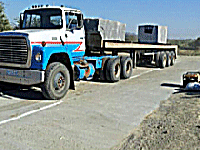 |
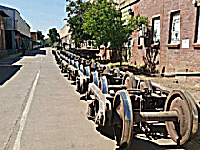 |
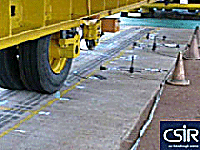 |
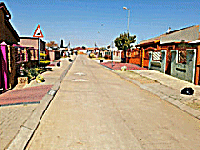 |
|
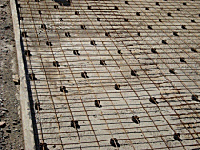 |
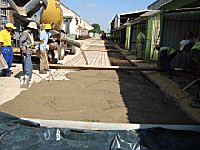 |
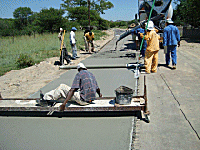 |
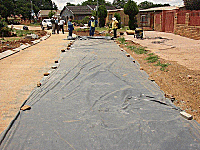 |
How can StoneRod basalt fibre mesh be used? First if all, the mesh is extremely light and can be handled very simply. The process requires that the first layer of concrete is placed halfway up the road formers. The roll of StoneRod mesh is rolled out over to top of the first layer of concrete, and then covered with the second layer to its full depth. The vibratory roller then compacts the concrete, and any blemishes are removed. Once bleeding has stopped, the road is floated smooth, and then broomed, to provide a non-skid finish. The surface is then covered with plastic sheeting to provide the necessary curing. Simple! And the need for spacer blocks and wire mesh that is heavy and awkward to handle, is removed from the equation.
Ecoshell dome homes
Monolithic.org, in the USA, has been at the forefront of thin-skinned development. They developed the "Ecoshell Dome Home", using an inflatable "Airform" to provide the structure's removable former. During early development, they used steel rebar for the reinforcement of the domes, but soon discovered that thin-skin concrete could not protect the steel from corrosion. They then pioneered the use of basalt fibre rebar, which by then, had been released in America, before switching to basalt rope as the means of reinforcing the domes. It was their video on basalt fibre that led to the formation of Basalt Technology (Pty) Ltd, in South Africa.
Their "Ecoshell" dome homes, which are covered in a section on this website, (See Dome Homes) have proved versatile and of great value in areas where there are shanty towns, or where natural disasters, such as earthquakes, or hurricanes, devastate communities. Efforts have been made to get various funders to move on the creation of dome home estates.
Basalt Technology (Pty Ltd., know how easily these structures can be erected. There is a massive market in South Africa, if we just want to replace the horrific shack problem. These smaller homes can be the bridge that starts home ownership for the poor. Of course, we would love the business, since thin-skinned domes need basalt rope reinforcement. However, we also recognise the massive housing need in South Africa, and this is why we have urged for the use of these magnificent alternatives to shacks.
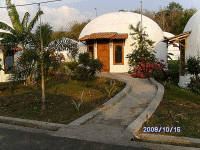 |
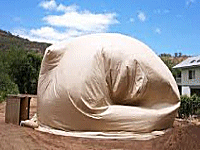 |
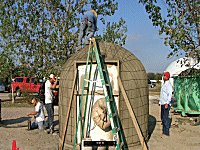 |
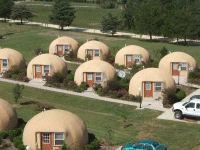 |
Thin skinned walls
Thin skinned walls can be constructed using dry, or wet mix, sprayed mortar, called 'Gunite" or "Shotcrete" As an alternative, the walls could be constructed with multi-layers of plaster. All three systems can provide suitable finishes. The texture of the wall can be smooth, as given by a smooth formwork system, or sandblasted timber, which will give a timber grain like finish. If sprayed, the typical stippled finish can be chosen, or the use of decorative mats, fixed to the shutters, can provide acceptable finished. Remember, the shutter finish will always be mirrored in the wall surface. So, ensure that the chosen finish will be achieved by correct shutter selection.
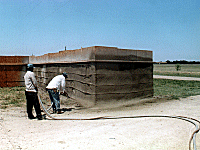 |
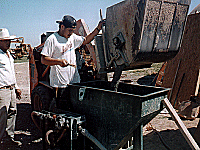 |
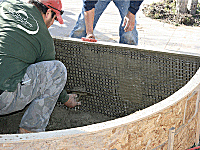 |
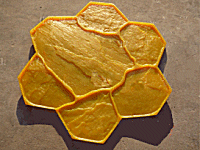 |
There are different ways to decorate the wall. It is not recommended that pigments be chosen, as variations are part of the pigmented concrete mixes. However, concrete stains can be applied. The stains soak into the concrete and remain in place for decades. Lime wash, or acrylic polymer paints can be applied. It all depends on the taste of the owner.
Thin-skinned systems are not possible using steel reinforcement! With the advent of composite materials, StoneRod basalt fibres rebar and meshes can now be utilised without having concern for future corrosion outbreaks. The StoneRod basalt fibre mesh is a product that can be used with confidence.
 |
We pride ourselves on our professional service, market knowledge, quality, and most competitive prices.
Return to Top of Page.